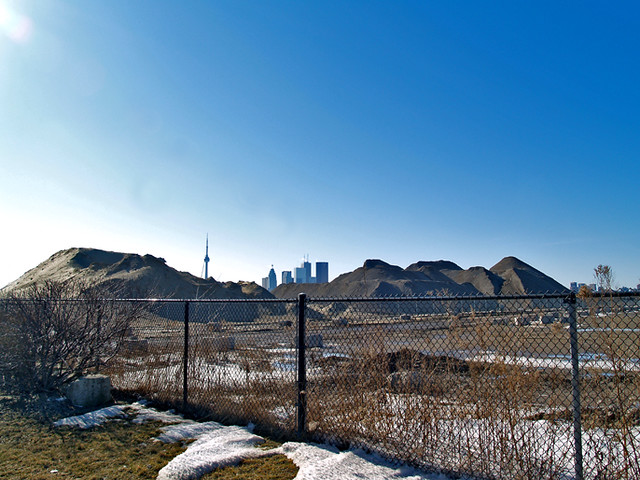Toronto’s waterfront, the largest revitalization of a brownfield site in North America, is being cleaned up, one pile of dirt at a time. Soil recycling turns brownfields that have been contaminated by land reclaiming and industry into public spaces and viable real-estate. Waterfront Toronto’s pilot soil recycling project began by two companies in September 2010 and it is expected that results will be seen in spring 2011. If the cleaned soil meets Ontario Ministry of Environment standards, then the decades long process to clean 2 million cubic meters of soil will begin.
I had the opportunity to talk with a couple of ladies who work on the remediation project. They also graciously gave me a tour the site. I was blown away by the passion of these two ladies for the project. When describing the project to me they offered rapid fire interesting facts ranging from the things that got pulled out of the soil (bicycles and old bottles) to what the cleaned soil can then be used for (playgrounds!).
As a waterfront city, Toronto’s ports were the keystone to its economic development. Industry and railways produced and transported materials from Toronto to the rest of Canada and turned a sleepy hollow into the powerhouse it is today. Environmental concerns were not on any policy or regulatory radar during the booming of industry and as such we have paid the price. What should be an entirely breathtaking waterfront is interrupted by brownfield sites with contaminated soil that exceeds current environment standards of safety.
The soil is cleaned through a process of physically removing large materials, such as concrete infill and metals from the soil. Then the soil is washed to remove toxins and other chemicals. The water used to clean the soil is then cleaned itself and used again. The soil washing is a remarkably closed loop system; though toxins are removed and disposed of there is little additional inputs required to clean the soil. Moreover, some of the infill that was used to extend land, such as concrete blocks, may be able to be used again in building material. At the Portlands, rubbish, animal waste, and building waste was used as infill. When that material was dug up, treasures such as old bicycles and antique bottles gave a little piece of insight into Toronto history.
This kind of revitalization is not easy though. It takes a long time and is a very expensive option that is not viable for many municipalities. The alternatives to soil recycling are digging and dumping, or capping (covering with concrete). Neither of these options adequately address the toxins that are in the soil and the potential to leech into the water table or cause other harmful effects.
Soil remediation on the waterfront can make as big of a difference to a city’s urban core as the industry did. As industry built up on Toronto’s waterfront, people fled the core to the serenity and fresh air of the suburbs. It was only when industry began to depart that people started moving back into the city. Imagine what the core could look like when the waterfront is an appealing space with green space, shops, cafes, and walking paths. Cleaning up old industrial sites also means that existing greenfields do not need to be developed, which helps to maintain a diminishing urban ecosystem.
This process does not happen in a vacuum. One key aspect of this project is the public consultation process and collaborations between organizations. The importance of due diligence, from the planning process to the shovel even entering the ground, is paramount for an enduring solution for the community. In addition to environmental concerns, issues such as public health and safety were communicated to stakeholders through public education and education pieces. With over a dozen stakeholders, Waterfront Toronto has many interests to balance, which will likely produce a solution that meets multiple needs. Once the results from the two companies are in, further rounds of consultations will take place.
Innovative ways of using existing land to meet environmental protection goals will make a significant difference in the challenges of shifting to resilient and healthy cities. Soil recycling is one of those innovations that we will hopefully see bring back to life the forgotten and neglected corners of Toronto.
Photo by Jay Morrison





6 comments
Thanks for the overview of this important project.
And happy International Women’s Day. I find the “ladies” descriptor peculiar (at best). How about appointing them by name and professional qualification/ occupation?
Agreed. Weird use of “ladies” by a lady.
Thank you for the style criticisms. Reflecting my use of the term “ladies” rather than their job titles is a colloquial slip that in truth doesn’t represent my own perspectives when writing about anyone. It is a term that I hear so often and disagree with yet why I choose to use it in this piece was purely stylistic. I recognize it takes away from the writing and the legitimacy of the project managers I spoke to.
So thank you for calling me on that one and I apologize for any offense. I hope you enjoy the rest of the article.
Hey jessica, cool article. you should turn this into a Jane’s Walk, just get the women together again and tour the site talking about exactly this kind of stuff. people would love to see the site and learn by being right there. would love to have it….. get in touch if you’re keen. info@janeswalk.net
Great topic; fascinating. One often hears about decontaminating brownfields but rarely thinks about what it entails. I have a feeling that another legacy of polluting industries of the past will be the need for large single-developer projects – it is so expensive to clean up the contamination that it is unfeasible for smaller players (individual home-builders or businesses) to take it on in smaller plots. At least that seems to be the case here in Montreal – and we aren’t even talking about such a complete recycling process!
I wonder too about the environmental impacts of digging up and transporting the soil as well as the water-purification process.
Did I read correctly that it will take decades to remediate this site?